July 08, 2025
This report is part of a series highlighting the real-world consequences of Illinois’ complex and overlapping government structure. To explore the other reports in this series, please visit:
- How Many Governments Maintain Green Bay Road?
- Too Many Cooks? Exploring Road Maintenance Across Government Layers in Glenview
By Lily Padula
From suburban streets to urban thoroughfares, Cook County’s roads reflect not only their asphalt conditions but also the varied priorities, fiscal capacities, and policy choices of the jurisdictions that maintain them. Pavement quality can shift dramatically between jurisdictions, underscoring disparities in infrastructure investment, tax bases, maintenance responsibilities, and long-term planning decisions - differences that often mirror broader socioeconomic divides. Drawing on Illinois Department of Transportation (IDOT) pavement performance data, this report systematically assesses road quality by jurisdiction, region, and road type, revealing an often-overlooked geography of infrastructure inequality across Cook County.
The Patchwork Nature of Cook County’s Road Network
Cook County’s road network spans around 944 miles across more than 130 municipalities, forming a complex system maintained by a patchwork of state, local, and tollway jurisdictions. These municipalities include a mix of cities, villages, and townships, all nested within the broader framework of Cook County. Each government entity operates with its own standards, capacities, and resource constraints, contributing to a fragmented approach to road maintenance. To assess pavement quality across this diverse network, two key rating systems are used: the Overall Rating and the Condition Rating Survey (CRS). The overall rating evaluates overall pavement condition by incorporating factors such as the International Roughness Index (IRI), rutting, faulting, and cracking, while the CRS rating provides a surface-level assessment of road quality, offering a more visual and immediate snapshot. When these measures are examined by jurisdiction, patterns begin to emerge that reflect deeper systemic disparities in road conditions, disparities that often correspond with the boundaries of jurisdictional responsibility and highlight the challenges of coordinating infrastructure management across multiple governments.
Jurisdictional Disparities in Road Quality
Analysis of road conditions by jurisdiction type in Cook County reveals notable differences in pavement quality. Toll roads maintained by the Illinois State Toll Highway Authority (ISTHA) are generally rated higher, with a majority falling into the “Good” or “Excellent” categories, which may reflect consistent revenue sources and dedicated maintenance systems. Other state-maintained roads tend to fall in the mid-range but show variation across different areas of the county, indicating potential inconsistencies in maintenance frequency or resource allocation. Local roads are more frequently rated as “Fair” or “Poor,” particularly in municipalities with smaller tax bases or older infrastructure. These patterns suggest varying levels of capacity to support ongoing maintenance across jurisdictions.
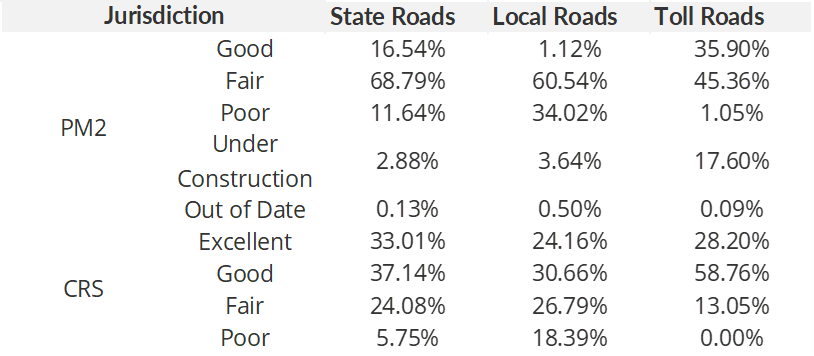
Regional Variation in Pavement Conditions
An analysis of road condition ratings for all types of roads (State, Local, and Toll) across Cook County’s North, South, West, and Chicago regions reveals that roads rated as “Fair” are the most common classification countywide. Fair-rated roads account for 68% in the North, 70.3% in the South, 78.8% in the West, and 66.5% in Chicago. This widespread prevalence of “Fair” ratings indicates that while many roadways remain passable, they are aging and increasingly vulnerable to deterioration without timely maintenance and reinvestment.
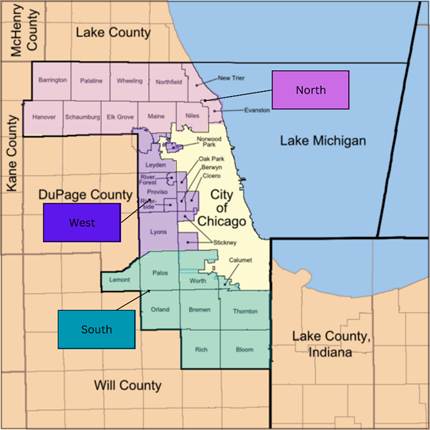
The West region (Berwyn, Cicero, Leyden, Lyons, Norwood Park, Oak Park, Proviso, River Forest, Riverside, and Stickney) stands out with the lowest share of roads rated “Good,” at just 6.3%, compared to 20% in the north, 18.2% in the South, and 10.5% in Chicago. The West also reports a high proportion of roads rated “Poor,” at 15%, exceeding the North and South, which both report approximately 11.5%. Chicago’s “Poor” condition share is notably higher, at 23%, indicating more significant deterioration within the city limits.
These figures reflect underlying disparities in fiscal capacity, infrastructure age, and maintenance resources across regions and jurisdictions. The concentration of roads in fair or poor condition in both the West region and the City of Chicago raises concerns related to safety, mobility, and long-term economic competitiveness, and may point to the need for more coordinated or targeted infrastructure investment. Meanwhile, municipalities in the North and South regions generally report stronger pavement conditions, potentially reflecting differences in local tax bases, infrastructure investment priorities, and administrative capacity. Collectively, these patterns highlight the complex relationship between road quality and the broader fiscal and governance landscape of Cook County.
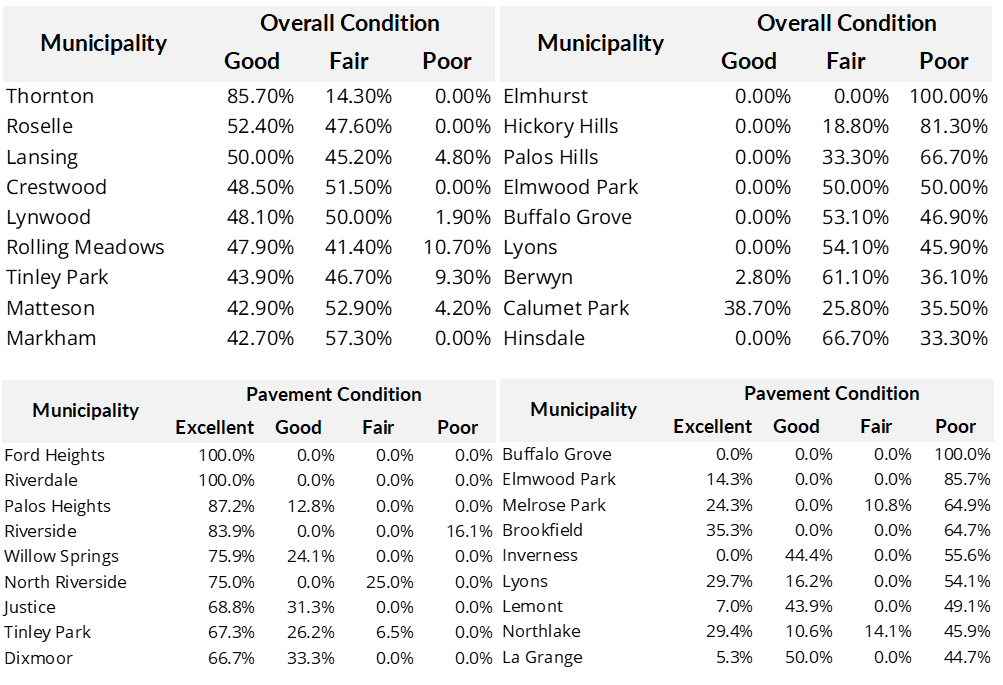
State-Maintained Roads: Regional Performance
State-maintained road data across Cook County also reveals distinct regional patterns in infrastructure quality, with notable disparities in both surface conditions and maintenance outcomes. The North region reports the highest share of roads rated “Good”, suggesting relatively stronger infrastructure investments or maintenance practices in certain areas. However, this region also contains a notable share of roads rated “Poor” (9.62%), highlighting significant pockets of deterioration. The average Condition Rating Survey (CRS) score for the North is 7.09, indicating generally acceptable surface conditions, though not without emerging concerns.
The South region presents a more balanced profile, with the highest count of “Fair”-rated road segments and a substantial share of “Good”-rated roads. It also has a similar number of roads rated “Poor” (10.99%) to the North. While the average percentage of roads rated poor in the South is on par with the North, the region has some pockets with the largest percentage of “Poor” rating, such as Hickory Hills and Palos Hills, with 100% of roads rated poor. With an average CRS score of 7.06, the South’s overall surface quality closely mirrors that of the North, suggesting that both regions face similar risks tied to aging infrastructure despite their different distributions of segment ratings.
In contrast, the West region displays the most acute infrastructure challenges. It has a notably smaller share of “Good” ratings (5.78%) and the highest concentration of deteriorated segments, in the lowest regional average CRS score of 6.13. This combination of a low proportion of well-maintained roads and a high concentration of deteriorated segments signals chronic underinvestment, deferred maintenance, or structural fiscal limitations in road management.
Chicago roads account for the largest count of “Poor” ratings (10.2%) and an average CRS score of 6.54, the second lowest after the West. These areas represent a potential oversight gap in state-level infrastructure planning and may warrant targeted review and strategic intervention.
Taken together, these findings underscore persistent regional disparities in state-maintained road conditions across Cook County. While the North and South show stronger performance in terms of “Good” and “Fair” ratings, the West and Chicago regions’ road networks appear to be in critical condition. Additionally, the predominance of “Fair” ratings in all regions indicates that many roads are at a tipping point. Without timely maintenance and reinvestment, these roads risk slipping into “Poor” condition, deepening existing inequities in infrastructure quality and mobility outcomes.
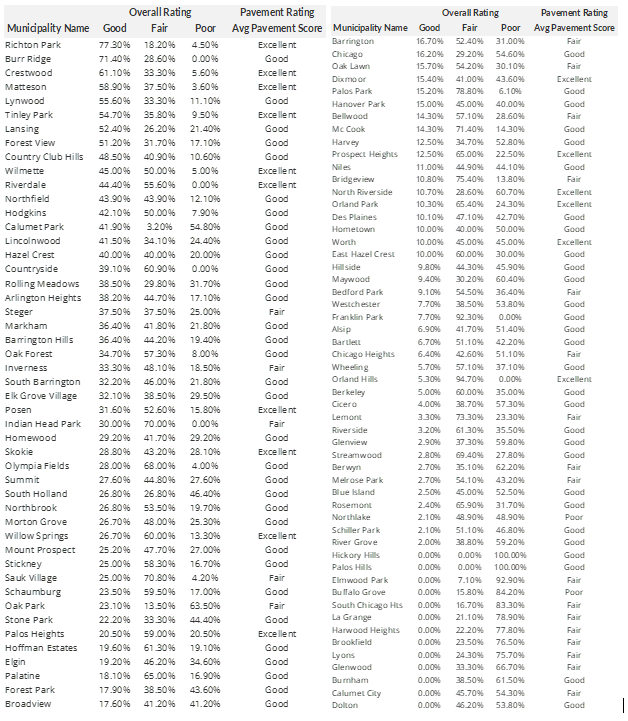
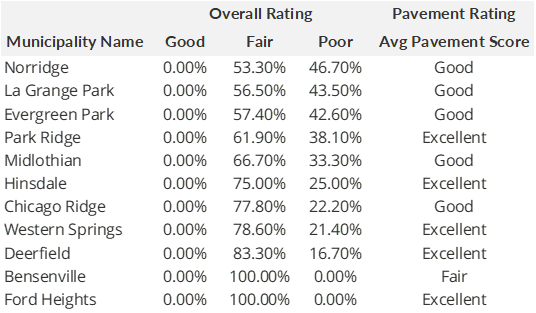
Consequences of Unequal Road Conditions
The quality of road infrastructure in Cook County is not only a technical issue but also a matter of equity, economic opportunity, and public trust. Persistent disparities in road conditions across communities reflect deeper structural challenges in how transportation resources are allocated and maintained.
Fiscal Capacity, Service Disparities, and Access to Infrastructure
Differences in road conditions across Cook County reflect, in part, underlying variations in local fiscal capacity, tax base strength, and administrative resources available to support infrastructure investment. Many municipalities and townships within Cook County face challenges in funding road maintenance due to limited revenues, constrained budgets, and competing service demands. These resource disparities can result in uneven maintenance schedules and long-term deferred repairs.
In certain communities, particularly in the South and West regions of Cook County, residents experience more frequent encounters with deteriorating roadways, which may affect reliable access to employment, education, healthcare, and other essential services. In addition to mobility challenges, deteriorated infrastructure may contribute to longer-term service delivery and economic development concerns, as businesses and residents may face increased risk of accidents, vehicle damage, and slow emergency response.
In recent years, several public agencies have recognized these variations in capacity and have incorporated technical assistance programs and prioritization frameworks into their infrastructure investment strategies. Such approaches can help ensure that limited transportation resources are deployed effectively across jurisdictions, with consideration for both asset management principles and service delivery outcomes for all residents.
Safety
The condition of roadways also has direct implications for public safety. Cracked pavement, potholes, and poor surface conditions increase the risk of accidents, vehicle damage, and injuries. In areas where roads have not been properly maintained, the likelihood of crashes and associated health consequences rises, posing an avoidable burden on residents and emergency services.
Economic Development and Mobility
Well-maintained roads are essential for economic development, supporting business operations, attracting investment, and enabling residents to move efficiently throughout the region. Infrastructure projects also generate employment, both directly through construction jobs and indirectly through increased commercial activity. However, communities with consistently poor infrastructure may struggle to retain or attract businesses, compounding economic disparities. Major initiatives such as the Rebuild Illinois capital program have highlighted the role of infrastructure investment in job creation and long-term economic revitalization, particularly in areas most in need of growth.
Public Trust and Governance
Visible disparities in road quality and infrastructure investment can significantly impact public perceptions of government effectiveness and fairness. When residents observe that their tax dollars are being used transparently and equitably, it can build confidence in public institutions. Conversely, when certain communities appear to be neglected or underserved, it can erode trust and reinforce perceptions of systemic inequity. Ensuring that infrastructure investments are not only data-driven but also publicly accountable is essential to maintaining legitimacy and public support for future transportation initiatives.
Conclusion
The condition of roads across Cook County reflects a varied landscape influenced by jurisdictional responsibilities, available resources, and infrastructure age. While certain areas, particularly toll roads and portions of the North and South regions, report higher pavement ratings, others, such as the West region and municipalities with more limited fiscal capacity, show a higher concentration of roads in fair or poor condition. The widespread presence of “Fair”-rated roads across all regions indicates a need for ongoing maintenance to preserve road quality and avoid more extensive deterioration over time.
This analysis reveals how disparities in road quality mirror deeper geographic and fiscal divides—essentially three very different Cook Counties when it comes to pavement condition. Addressing these gaps will require continued coordination among state, county, and local agencies, along with data-informed planning and targeted support that prioritize equity, long-term performance, and consistent road quality throughout the county.
